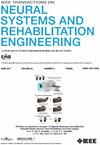增强脑卒中后运动恢复的神经可塑性:机制、模型和神经技术。
IF 4.8
2区 医学
Q2 ENGINEERING, BIOMEDICAL
IEEE Transactions on Neural Systems and Rehabilitation Engineering
Pub Date : 2025-03-18
DOI:10.1109/TNSRE.2025.3551753
引用次数: 0
摘要
中风仍然是一项重大的全球健康挑战,造成巨大的社会经济负担。脑卒中后神经康复旨在通过有效的神经调节来最大限度地恢复功能并减轻持续性残疾,而许多患者经历了较长时间的恢复期,但结果并不理想。这篇综述探讨了创新的神经技术和治疗策略,以增强中风后运动恢复的神经可塑性,特别关注亚急性和慢性期。我们研究了神经技术应用的关键神经可塑性机制和康复模型,包括代换模型、半球间竞争模型和双峰平衡恢复模型。基于这些理论基础,目前的神经技术被分为神经可塑性的内源性驱动(例如,任务导向训练,脑机接口)和外源性驱动(例如,脑刺激,肌肉电刺激,机器人辅助的被动运动)。然而,大多数方法缺乏将意志行为与脑神经调节相结合的量身定制的调整。鉴于当前神经技术的异质性效应,我们建议未来的方向应该集中在个性化康复策略和闭环神经调节上。这些先进的方法可能为神经可塑性提供更深入的见解,并有可能扩大中风患者的康复可能性。本文章由计算机程序翻译,如有差异,请以英文原文为准。
Enhancing Neuroplasticity for Post-Stroke Motor Recovery: Mechanisms, Models, and Neurotechnology
Stroke remains a significant global health challenge, imposing substantial socioeconomic burdens. Post-stroke neurorehabilitation aims to maximize functional recovery and mitigate persistent disability through effective neuromodulation, while many patients experience prolonged recovery periods with suboptimal outcomes. This review explores innovative neurotechnologies and therapeutic strategies enhancing neuroplasticity for post-stroke motor recovery, with a particular focus on the subacute and chronic phases. We examine key neuroplasticity mechanisms and rehabilitation models informing neurotechnology use, including the vicariation model, the interhemispheric competition model, and the bimodal balance-recovery model. Building on these theoretical foundations, current neurotechnologies are categorized into endogenous drivers of neuroplasticity (e.g., task-oriented training, brain-computer interfaces) and exogenous drivers (e.g., brain stimulation, muscular electrical stimulation, robot-assisted passive movement). However, most approaches lack tailored adjustments combining volitional behavior with brain neuromodulation. Given the heterogeneous effects of current neurotechnologies, we propose that future directions should focus on personalized rehabilitation strategies and closed-loop neuromodulation. These advanced approaches may provide deeper insights into neuroplasticity and potentially expand recovery possibilities for stroke patients.
求助全文
通过发布文献求助,成功后即可免费获取论文全文。
去求助
来源期刊
CiteScore
8.60
自引率
8.20%
发文量
479
审稿时长
6-12 weeks
期刊介绍:
Rehabilitative and neural aspects of biomedical engineering, including functional electrical stimulation, acoustic dynamics, human performance measurement and analysis, nerve stimulation, electromyography, motor control and stimulation; and hardware and software applications for rehabilitation engineering and assistive devices.

 求助内容:
求助内容: 应助结果提醒方式:
应助结果提醒方式:


